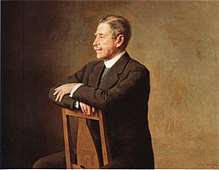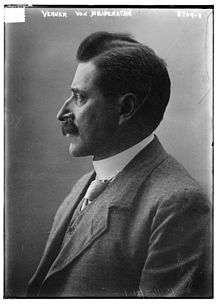Verner von Heidenstam
Carl Gustaf Verner von Heidenstam (6 July 1859 – 20 May 1940) was a Swedish poet, novelist and laureate of the Nobel Prize in Literature in 1916.[1] He was a member of the Swedish Academy from 1912.[2] His poems and prose work are filled with a great joy of life, sometimes imbued with a love of Swedish history and scenery, particularly its physical aspects.
Verner von Heidenstam | |
|---|---|
 Portrait by Johan Krouthén, 1931 | |
| Born | Carl Gustaf Verner von Heidenstam 6 July 1859 Olshammar, Örebro County, Sweden |
| Died | 20 May 1940 (aged 80) Övralid, Östergötland, Sweden |
| Occupation | Poet, novelist |
| Nationality | Swedish |
| Notable awards | Nobel Prize in Literature 1916 |
| Spouse | Emilia Uggla (m. 1880, d. 1893); Olga Wiberg (m. 1893, div.); Greta Sjöberg (m. 1900, div.) |
| Relatives | Gustaf von Heidenstam (father) |
Biography
He was born in Olshammar, Örebro County on 6 July 1859 to a noble family. He studied painting in the Academy of Stockholm, but soon left because of ill health. He then traveled extensively in Europe, Africa and the orient.[3] He was at once greeted as a poet of promise on the publication of his first collection of poems,[4] Vallfart och vandringsår (Pilgrimage: the Wander Years, 1888). It is a collection of poems inspired by his experiences in the orient and marks an abandonment of naturalism that was dominant then in Swedish literature.
His love for beauty is shown also by the long narrative poem Hans Alienus (1892). Dikter ("Poems", 1895) and Karolinerna (The Charles Men, 2 vols., 1897–1898), a series of historical portraits of King Charles XII of Sweden and his cavaliers, shows a strong nationalistic passion.[5][6] English translations of short stories from Karolinerna can be found in the American-Scandinavian Review (New York), May 1914, November 1915, and July 1916.[4] The two volumes of Folkunga Trädet (The Tree of the Folkungs, 1905–07) are the inspired, epic story of a clan of Swede chieftains in the Middle Ages.
In 1910 a controversy was waged in Swedish newspapers between a number of Swedish literary men on the topic of the proletarian “degradation” of literature, the protagonists of the two opposing camps being August Strindberg and Heidenstam. Professors Lidforss and Böök also took part. Heidenstam's chief contribution was the pamphlet, directed chiefly against Strindberg, "Proletärfilosofiens upplösning och fall" ("The Decline and Fall of the Proletarian Philosophy").[7]
Heidenstam's poetical collection Nya Dikter, published in 1915, deals with philosophical themes, mainly concerning the elevation of man to a better humanity from solitude.
He died at his home Övralid on 20 May 1940.
Works

- Från Col di Tenda till Blocksberg , pictures of travel (1888)
- Vallfart och vandringsår (1888)
- Renässans (1889)
- Endymion (1889, novel)
- Hans Alienus (1892)
- Dikter (1895)
- Karolinerna (The Charles Men, 1897–98, novel)
- Sankt Göran och draken (1900)
- Klassizität und Germanismus (published in German, Vienna 1901)[8]
- Heliga Birgittas pilgrimsfärd (Saint Bridget's Pilgrimage, 1901)
- Ett folk (1902)
- Skogen susar (The Forest Whispers, 1904)
- Folkungaträdet (The Tree of the Folkungs, 2 volumes, 1905–1907)
- Svenskarna och deras hövdingar (1910, historical lectures)
- Nya Dikter (1915).
Works in English translation
- A King and his Campaigners (1902)
- The Soothsayer (1919)
- Sweden's Laureate. Selected Poems of Verner Von Heidenstam (1919) - (trans. by Charles Wharton Stork)
- The Birth of God (1920)
- The Charles Men (1920) - (trans. by Charles Wharton Stork)
- The Swedes and their Chieftains (1925) - (trans. by Charles Wharton Stork)
- The Tree of the Folkungs (1925)
Notes
- Stork, Charles Wharton (1916). "Verner von Heidenstam," The Nation, Vol. CIII, No. 2683, p. 509.
- Warme, Lars G. (1996). A History of Swedish Literature. University of Nebraska Press, p. 276.
- Sohrabi, Bahram (2005). "Early Swedish Travelers to Persia," Iranian Studies 38 (4), pp. 631–660.
- Rines 1920.
- Facos, Michelle (1998). Nationalism and the Nordic Imagination: Swedish Art of the 1890s. University of California Press, p. 63.
- Barton, H. Arnold (2002). "The Silver Age of Swedish National Romanticism, 1905-1920," Scandinavian Studies 74 (4), pp. 505–520.
- Gustafson, Alrik (1940). "Nationalism Reinterpeted: Verner von Heidenstam." In: Six Scandinavian Novelists. New York: Biblo & Tannen, p. 169.
- Here the author advocates a sort of artistic exclusiveness; Heidenstam appears as the champion of the classic spirit, which he considers essentially aristocratic, as opposed to the Germanic attitude which he considers democratic and reprehensible.
Jacob Wittmer Hartmann (1920). . In Rines, George Edwin (ed.). Encyclopedia Americana.
Further reading
- Barton, Hildor Arnold (2003). Sweden and Visions of Norway: Politics and Culture, 1814-1905. SIU Press.
- Larsson, Hans Emil (1909). "Swedish Literature," The Journal of English and Germanic Philology 8 (3), pp. 313–329.
External links
| Wikimedia Commons has media related to Verner von Heidenstam. |
- Verner von Heidenstam at Project Runeberg
- Works by Verner von Heidenstam at Project Gutenberg
- Works by or about Verner von Heidenstam at Internet Archive
- Works by Verner von Heidenstam at Swedish Literature Bank (in Swedish)
- Newspaper clippings about Verner von Heidenstam in the 20th Century Press Archives of the ZBW
| Cultural offices | ||
|---|---|---|
| Preceded by Carl David af Wirsén |
Swedish Academy, Seat No.8 1912-1940 |
Succeeded by Pär Lagerkvist |
